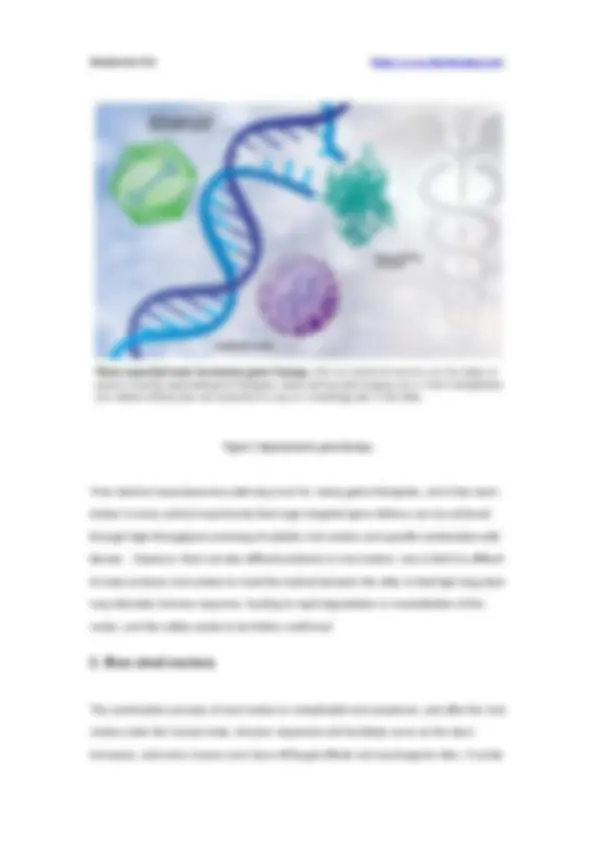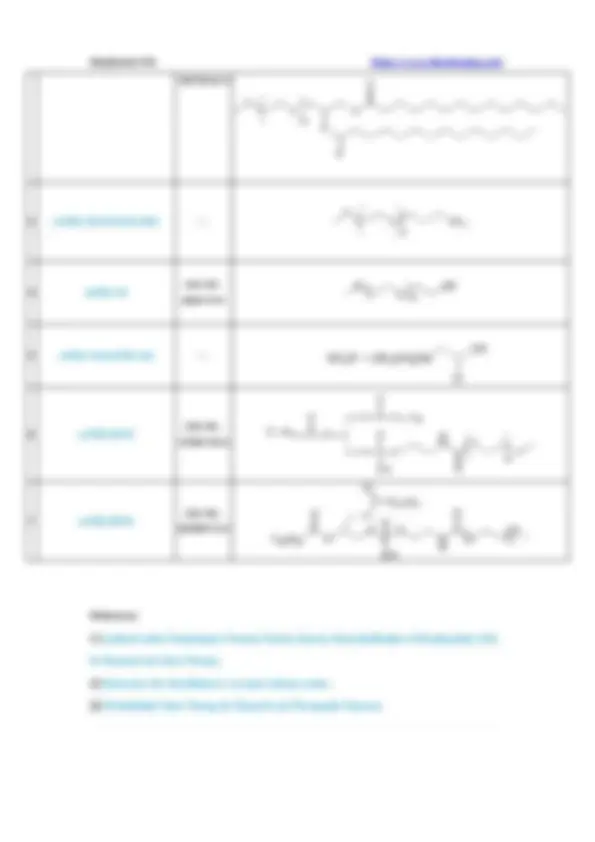







Study with the several resources on Docsity

Earn points by helping other students or get them with a premium plan


Prepare for your exams
Study with the several resources on Docsity

Earn points to download
Earn points by helping other students or get them with a premium plan
Community
Ask the community for help and clear up your study doubts
Discover the best universities in your country according to Docsity users
Free resources
Download our free guides on studying techniques, anxiety management strategies, and thesis advice from Docsity tutors
An overview of gene therapy, discussing its purpose, the role of vectors, and the differences between viral and non-viral vectors. The text focuses on Biopharma PEG and the use of adenovirus as a gene delivery vector, detailing their advantages, mechanisms, and applications in gene therapy.
Typology: Summaries
1 / 9

This page cannot be seen from the preview
Don't miss anything!






On January 25, 2022, Nature published an article listing seven technologies worthy of attention this year. Targeted genetic therapies was on the list. The remaining six technologies are: Fully finished genomes, Protein structure solutions, Quantum simulation, Precise genome manipulation, Spatial multi-omics), CRISPR-based diagnostics.
Gene therapy refers to the delivery of exogenous genes with normal functions to target cells in the human body with a certain carrier, and the purpose of treating diseases is achieved by correcting the defective genes. If chemotherapy is a "symptom cure", then gene therapy is a "cure for the root cause". With the gradual emergence of gene therapy in clinical applications, it has become one of the most rapidly developing directions in the field of biomedicine in recent years. Most gene therapy is to obtain modified functional cells locally or in vitro, and then transplant them into the patient. However, this method is limited in drug delivery and cannot precisely deliver the drug to the target tissue. Of course, except for the liver, because the liver has the function of filtering blood, in addition to intravenous infusion, even subcutaneous injection can achieve specific targeted delivery to the liver. For gene drug delivery in extrahepatic tissues, major pharmaceutical companies are making steady progress to seize key technologies. Drug carrier is the key technology of gene therapy, and commonly used carriers can be divided into viral vectors and non-viral vectors.
Depending on the source and nature of the vector, gene therapy vectors can be divided into two categories: viral vectors and non-viral vectors. Viral vectors mainly include
lentivirus, adenovirus, retrovirus, adeno-associated virus, etc., and non-viral vectors mainly include naked DNA, lipid carriers, polymer nanoparticles, and exosomes. Among them, viral vectors are the main delivery vectors currently used, and about 70% of the genetic drugs in clinical trials are viral vectors.
Viral vectors are the most commonly used vectors for gene therapy, mainly because viral vectors can naturally infect cells. The genome of the virus includes a coding region and a non-coding region. The genes in the coding region produce the structural and non-structural proteins of the virus, while the non-coding region contains cis-acting elements necessary for the replication and packaging of the virus. Gene recombination technology can be used to modify the virus, eliminating the oncogene in the genome and at the same time replicating the defective virus. Under normal circumstances, in order to insert enough exogenous DNA into the virus, the unnecessary and essential genes can also be deleted at the same time if necessary, so as to increase the capacity of the viral vector for exogenous DNA. Figure 1 Viral vectors for gene therapy
The delivery mechanism of adenovirus vectors is mainly receptor-mediated. The recombinant adenovirus vectors enter the cell under receptor-mediated endocytosis, and the genome carried by the adenovirus vectors enter the nucleus, but does not integrate into the host cell genome, remaining outside the chromosome. Adenoviral vectors are the most commonly used vaccine vectors and are less used in other areas. (3) Adeno-associated virus vectors Adeno-associated virus (AAV) vectors are non-integrated viral vectors (or the proportion of gene integration ability is extremely low), which exist in an independent free form after entering human cells and will not integrate into the host cell genome, thus reducing related risks and showing good safety. Adeno-associated virus (ADV) is a class of single-stranded DNA deficient viruses with the simplest structure. It has no envelope and is shaped as naked 20-hedron particles. The scientific consensus is that it does not cause any human disease and can infect different target organs according to the different serum. Recombinant adeno-associated virus (rAAV) particles as gene therapy vectors have successfully transduced mammalian cells since the early 1980s. Recombinant adeno-associated virus particles bind to glycosylated receptors on the surface of host cells, and enter cells to form endosome through clathrin-mediated endocytosis. The subunit of viral capsid changes conformational changes after acidification, and the virus carried by it disintegrates from the endosome and enters the nucleus. At this point, the single-stranded DNA released from the capsid cannot be transcribed, requiring the formation of double-stranded DNA with the assistance of DNA polymerase of the host cell.
Figure 2 Approaches to gene therapy Viral vectors have become a delivery tool for many gene therapies , and it has been shown in many animal experiments that organ targeted gene delivery can be achieved through high-throughput screening of suitable viral vectors and specific combination with tissues. However, there are two difficult problems in viral vectors: one is that it is difficult to mass produce viral vectors to meet the market demand; the other is that high drug dose may stimulate immune response, leading to rapid degradation or neutralization of the vector, and the safety needs to be further confirmed.
The construction process of viral vectors is complicated and expensive, and after the viral vectors enter the human body, immune responses will inevitably occur as the dose increases, and some viruses even have off-target effects and carcinogenic risks. A series
Polymer nanoparticles, as gene delivery vehicles, are usually combined with gene editing technology. For example, Sarepta Therapeutics' polymer nanoparticle delivery platform (NanoGalaxy) combined with Sarepta's gene editing technology to develop a novel gene editing therapy for the treatment of neuromuscular diseases. Preliminary in vivo results show that polymer nanoparticles deliver genomes to specific muscle tissues after systemic administration without the assistance of targeted delivery of viral vectors. The polymer nanoparticle delivery platform contains thousands of polymers with different chemical properties, which can be selected according to the different targets to be reached, and carry different load genomes. The polymer nanoparticles of the NanoGalaxy technology platform can deliver DNA, RNA or CRISPR gene editing systems. Figure 3 Working principle of NanoGalaxy delivery technology platform (3) Exosomes Exosomes are discoid vesicles with a diameter of 40-160 nm wrapped in lipid bilayers. They are derived from multivesicular bodies formed by the invagination of intracellular lysosomal particles. The outer membrane of multivesicles is fused with the cell membrane. After being released into the extracellular matrix, exosomes are natural carriers of intercellular communication, which have been developed as drug delivery vehicles at present.
Compared with other delivery systems, exosomes have the following advantages: as multifunctional carriers, exosomes can encapsulate and deliver various biological macromolecules such as small RNA, mRNA, DNA, and proteins; exosomes have the ability to cross physiological barriers , and can even cross the blood-brain barrier; exosomes can be genetically engineered to modify their surface proteins to achieve targeted delivery to specific tissues, avoiding toxic side effects caused by accumulation in non-essential organs. At present, exosome-based targeted delivery gene therapy has shown the advantages of enhanced efficacy and improved safety, and other companies have combined lipid nanoparticles and exosomes to develop a new generation of non-viral gene therapy. In the history of gene therapy delivery, various delivery methods have been developed. From viral vectors to non-viral vectors, from adenovirus to exosomes, with the advancement and development of science and technology, gene therapy also benefits. It is believed that with the continuous innovation of technology, gene therapy will bring more possibilities for drug development. Biopharma PEG is a worldwide leader of PEG linker supplier. We have been focusing on the development of a full range of medical applications and technologies for nanocarrier systems, including various types of nanoparticles, liposomes, micelles, etc. We are committed to providing a variety of PEG-liposome derivatives, including mPEG, DSPE lipids with different molecular weight and functional PEG. We can provide the following PEG products that used in COVID-19 mRNA vaccines. 1 mPEG-N,N-Ditetradecylacetamide (ALC-0159) CAS No. 1849616-42- 2 mPEG-DMG CAS NO.